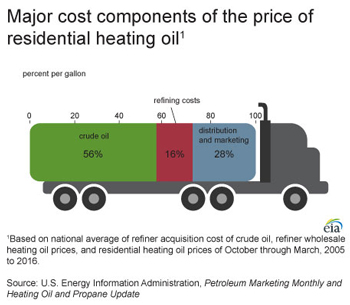Oil Prices - See Today's Oil Prices and Why They Rise and Fall
Find Oil Prices by Zip Code
Why does oil prices rise and fall?
Of all industries in the world, oil industry is indeed an international business which affects most countries in the world.
As the oil is the most consumed energy, it plays a vital role in daily lives as well as economy and social development. Also, the oil industry leads to new technology development both directly and indirectly. It has been deployed as a means for economy and political negotiation.
Nevertheless, “crude oil” when refined into various petroleum products having different attributes: i.e. gasoline, diesel, aviation fuel, kerosene,and fuel oil, and others, its value will be maximized. The price of crude oil is thus determined by the type and quality of the crude oil itself. Once distilled, heavy and light crude oil yield several refined products e.g. gasoline and diesel to serve demands at different quantities. In addition, sour and sweet crude are also priced differently.
Forecasting or estimating oil price in the future is sophisticated because oil is the commodity product which is available globally. Unlike other products, the quality of oil product can be made different to serve different needs of consumers.
As the oil market is mainly regional activities which are born of cooperation from various countries and parties having different needs and environments, several factors then involve both directly and indirectly. Nevertheless, the oil prices can be analyzed at both regional and global levels.

Main factors that affect oil prices
Fundamental factor -The fundamental factor of oil price determination, is demand and supply like other type of products. Demand and supply of oil products change according to situation and circumstances. In any market situation, imbalance between demand and supply can affect prices. For instance, in the case of more demand than supply (under supply), the price is likely to rise. The variables which result in imbalance between demand and supply include:
Economic growth is the factor that positively corresponds with the price of oil. When theeconomy grows, oil demand in our daily lives as well as demand to cope with economy expansion will increase. If the world’s production is unable to meet the the growth, the price of oil is definitely on a rise. In an opposite vein, the price of oil will decrease if the economy growth is minimal in the light of oversupply of oil. It is noted that the world economy growth rate in every region must be taken into consideration.
Weather - Seasonal change is another factor which causes the imbalance between oil demand and production. Especially, the consumption patterns in Europe and the USA are clearly dictated by the season. That is, in winter, the demand of heating oil (mainly diesel and fuel oil) is higher than other types of oil. Normally, the oil traders start to increase inventory of heating oil in the fourth quarter of the year to prepare for the winter at the beginning of the year. As a result, the price of oil tends to increase during the said period. In addition, the demand is sensitive to the coldness. The colder it gets, the higher the demand is. Due to the fears of the oil shortage, the consumers increase their oil inventories which also results in an oversupply and may affect the price as well.
Meanwhile, summer is the driving season for the western countries, starting in the third quarter of the year or around July. Given that the demand of gasoline is higher than other types, its price tends to increase in the second quarter of the year. In sum, the weather is another fundamental factor which contributes to the changing demand and supply and the price of oil also results in an oversupply and may affect the price as well.
for the full story and courtesy of: http://www.pttplc.com/en/Media-Center/Energy-Knowledge/Documents/petro_01_en.pdf